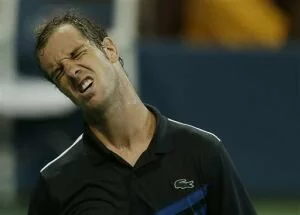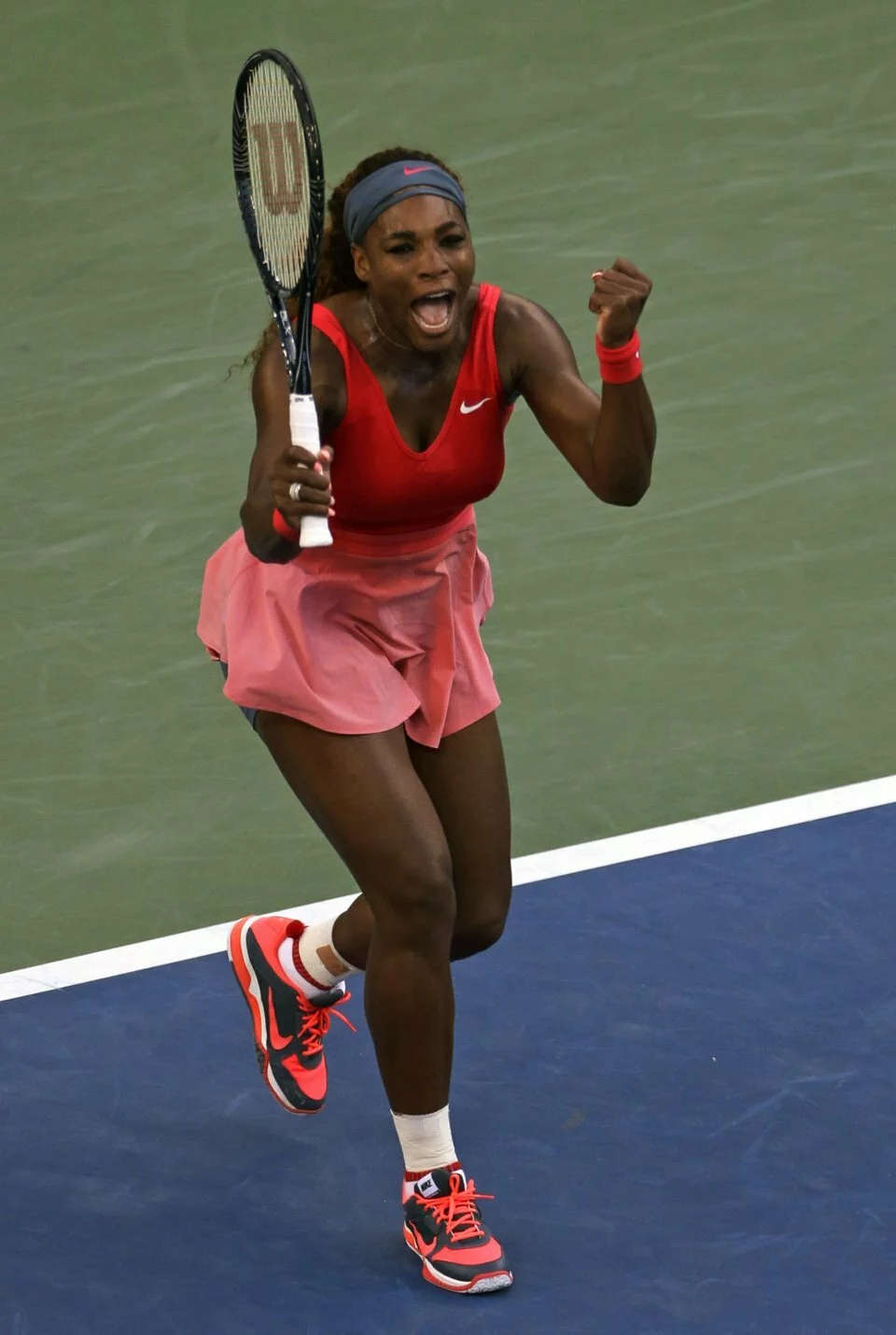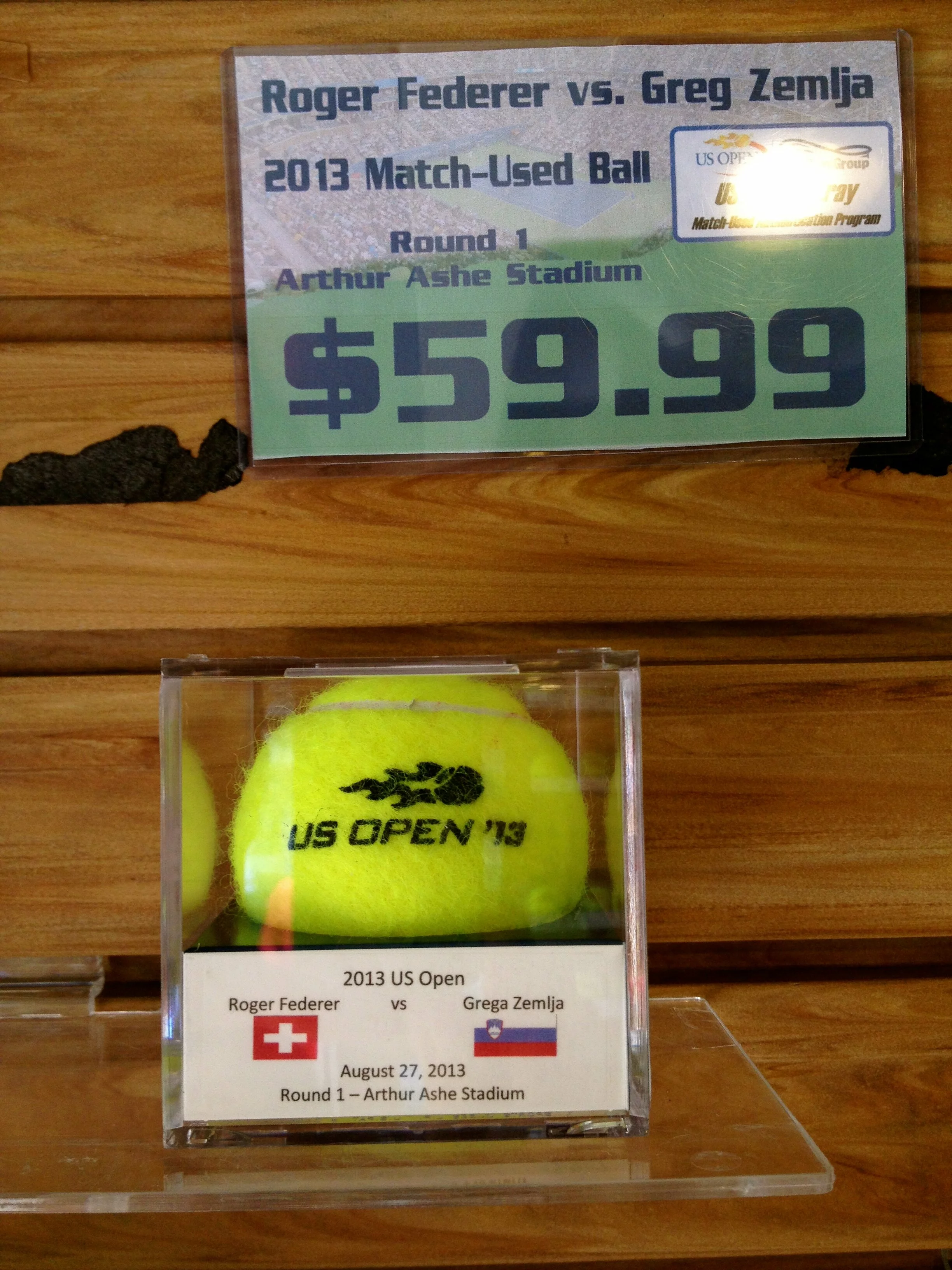Here's to the losers, the guys who get drilled, again and again, who see their hopes of glory dashed by Rafa, Roger, Nole. Theirs is the glory of trying again.
Stan Wawrinka, long overshadowed by his countryman and friend, Roger Federer, played his way into the semis (a first for him in a Slam), the headlines and many fans' hearts with his smart, spirited play.
 Wawrinka looks to a nihilist to defeat Tennis Hate. Photo: Amy Eddings.
Wawrinka looks to a nihilist to defeat Tennis Hate. Photo: Amy Eddings.
"I love you, Stan, " said a guy sitting behind me at Louis Armstrong during Wawrinka's nearly 3 hour match against 5th-seed Tomas Berdych. He inspires bromance, does Stan the Man, with his beautiful one-handed backhand, his all-court game, his deftness at net, his weird spiky hair. And, for me, his tattoo.
The New York Times wrote about it, and how it sums up Wawrinka's philosophy of life on the tour. It's from the Irish grouch, playwright Samuel Beckett:
Ever tried. Ever failed. No matter. Try again. Fail again. Fail better.
“It’s my vision of my job and my life in general,” Wawrinka said. “In tennis, as you know, if you are not Roger or Rafa and Djokovic or Andy now, you don’t win so many tournaments and you always lose. But you need to take the positive of the loss and you need to go back to work.”
Wawrinka's tattoo, and his explanation of its meaning to him, shows he's found value in the game beyond winning."
The Times titled the article "The Power of Positive Thinking," but it's not positive thinking at all. It's not about cultivating positive expectations for the future, some sort of magical thinking that is supposed to create the conditions in which you emerge victorious, hoisting the trophy. Wawrinka's tattoo, and his explanation of its meaning to him, shows he's found value in the game beyond winning. Ever failed. No matter. He loves the pursuit of excellence. That excellence has borne fruit that may not taste like Federer's 17 majors, but they are awfully juicy all the same. He defeated two Top Ten players, Berdych and US Open defending champ Andy Murray, on his road to the semis. He almost got the number one player in the world, Novak Djokovic, in their amazing five set match.
The press applauded him when Wawrinka walked into the interview room.
He still looked for positives, even after letting victory slide away, 6-2, 6-7, 6-3, 3-6, 4-6.
"I think I was playing better than him. I was doing much more things than him," said Stan. "But he's not No. 1 for nothing. He was staying with me all the match, and at the end he pushed me, pushed me far, far, far back. I had to find everything I had in my body today to stay with him, and he won the match. But, yeah, I think was still a good tournament."
Then there's Richard Gasquet, a tennis prodigy who hasn't done as well as an adult as he did as a kid. He, too, made it into the semis of the US Open for the first time in his career, in a journey that included two 5-set victories. One of them was against Canada's First Big Thing, Milos Raonic.
 Ouch, that hurts. With his semifinal loss, Gasquet is 0-11 against Rafa.
Ouch, that hurts. With his semifinal loss, Gasquet is 0-11 against Rafa.
I was at that match, on Court 17. It was a day session match that had stretched into the very humid night. Raonic and Gasquet looked like they had their shirts wheat-pasted onto their torsos. I had been in the stands for the first two sets and had left after watching Raonic aceing out several 40-0 games in a row. Gasquet, the old dog, is getting euthanized, I thought.
Wrong. I hustled back after seeing on a scoreboard that it was in a 4th set. Gasquet had found a way to answer Raonic's serves. The two were in the process of pushing one another to a sublime place, and the crowd was with them.
There were competing chants of "Let's go, Rao-nic!" and "All-ez, Gas-quet!" It was like a Davis Cup match, but the setting was neutral ground, New York City, home of all nations. One guy did a goofy, raspy stage whisper, "Allez, Gasqueeeeeeet!" during the quiet moments of the match, just as the Frenchman was toeing up to the baseline to serve. The mood was electric, and so was the tennis. Three tiebreakers sets and four and a half hours later, Gasquet emerged sweaty and victorious, 6-7, 7-6, 2-6, 7-6, 7-5.
Of course, I'm jealous of Nadal."
But then there was, as there always is deep in a Slam, Rafael Nadal. His unbeaten hard court season continued with a 6-4, 7-6, 6-2 march over Gasquet. At least Gasquet broke Rafa's serve. No one else had done that yet during this tournament.
Gasquet is now 0-11 against Nadal, a guy he once beat when they were kids. Poor Richard admitted to some Tennis Hate -- just a little -- against his fellow 27-year-old.
"Of course I’m jealous of Nadal, who won Roland Garros eight times,” he told the New York Times. “I would have preferred it had been me, but hey, I’m not badly off. I was eighth in the world, seventh in the world. I have a lot of good fortune to be where I am in life. I’m quite happy, but of course I would have preferred to be in Nadal’s spot in tennis terms. It’s normal. I just admire what he’s done."
Gasquet said he was happy being in a semifinal, but now he's setting his sights on winning enough points to play the Masters Cup. Already, he's moving on, looking ahead, setting another goal. Try again. Fail again. Fail better.
 Amy Eddings Posted on
Amy Eddings Posted on  Friday, September 13, 2013 at 6:22PM
Friday, September 13, 2013 at 6:22PM
The courts at Central Park. Fewer people are making reservations or buying tennis permits because of 2011 fee hike. Photo: Amy Eddings
 Independent Budget Office,
Independent Budget Office,  New York City Parks Department,
New York City Parks Department,  tennis permit fees | in
tennis permit fees | in  Tennis Courts,
Tennis Courts,  tennis hate
tennis hate





